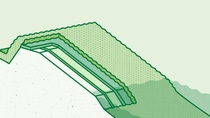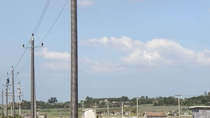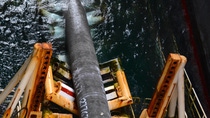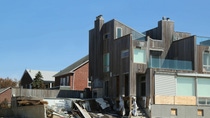Construction
At the mercy of the elements ...or protected by Elastocoast®
Dikes protect Germany’s coasts and river banks – a task made more difficult by the predicted rise in the sea level. A revetment of Elastocoast® can strengthen existing coastal protection.

According to the experts, global warming will cause sea levels to rise by up to 50 centimeters in the coming years. Of course, no scientist can foresee when and how this rise will actually occur – or the ultimate consequences. This highlights the obvious need to intensify coastal protection and flood prevention activities and particularly to raise the dikes. However, in view of the financial investment involved and for practical reasons such spatial constraints, raising the dikes is difficult or impossible to achieve. Another dangerous scenario associated with this issue is dike overtopping, since subsequent erosion on the land side inevitably results in complete dike failure. This is where Elastocoast® opens up totally new horizons in coastal protection.
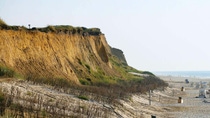

2: When severe storms sweep across Germany in the fall and winter, the water sometimes comes right up to the front door.
Rock-solid with Elastocoast®
Revetments of Elastocoast® are a new, extremely effective coastal protection system. More precisely, they are an aggregate (crushed rock) mechanically bonded with an environmentally compatible 2-component polyurethane plastic. This mixture is applied to previously prepared dikes, slopes, breakwaters and other sea- and freshwater shorelines. The outcome is a highly durable, strong and hence secure bulwark against the waves and flooding. Elastocoast® makes existing dikes safer without their having to be continually raised. Instead, an open-pored wearing course prevents wave impact energy from attacking and destroying their surface. The surface protected with Elastocoast® creates a higher standard of safety by significantly reducing wave run-up with its open, energy-absorbing structure. The wave energy is distributed over a larger area, thus diminishing local concentrations of surface pressure.
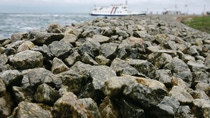
The revetment as a whole is sub-jected to less stressing. This way, older dikes can be made safer, even when they are completely overtopped – even if higher standards of coastal protection are called for as a result of long-term climate change and rising sea levels. The PU system can be used for trouble-free repairs to older dikes, as Elastocoast® can be applied straight onto the existing revetment – without elaborate pretreatment and with much less manpower.
In the Netherlands we need new coastal protection methods because traditional dyke design will not be sufficient to protect our coasts and the hinterland from the rising sea level over the coming years.
Weathering the storm – stemming the tide of rising costs.
Thanks to Elastocoast®’s extremely open-porous structure and high mechanical strength, revet-ment courses can be designed up to 50 percent thinner. Revetments grouted with bitumen or concrete require riprap 200 to 300 mm in size. Elastocoast®, on the other hand, makes use of aggregates of smaller sizes (20 to 60 mm). This quickly yields considerable savings in the cost of construction materials, transport and processing. The overall benefit is of the order of 20 to 30 percent. Using Elastocoast® thus not only improves safety, but also makes installation schedules more flexible and significantly eases the strain on the coastal protection and flood prevention budget.
But there’s another advantage of the revet-ment’s extremely porous nature. During flooding, storms and heavy rain, the dikes become waterlogged with a dangerous build-up of pressure. When water levels then fall, this pressure has to be released as quickly as possible. Here again, the open-porous Elastocoast®-rock mixture proves to be vastly superior to other systems and techniques. River bank armoring and flood prevention. What has already proven successful in coastal protection can also be used on river banks and canals. The goal here is also to create a strong and near-natural revetment to consolidate shore zones and armor them against traffic-induced waves and – as in the case of the Elbe River – against the tides. In waterway engineering, there is also the possibility of underwater installation where the rock-PU mix, after sufficient reaction time, is poured into the water close to the bank and compacted. The principle is just as simple as for dike construction and prevents the banks from disintegration and damage due to strong currents.

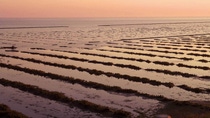
2: Protecting the shorelines is an integral part of infrastucture in coastal areas.
River bank armoring and flood prevention.
What has already proven successful in coastal protection can also be used on river banks and canals. The goal here is also to create a strong and near-natural revetment to consolidate shore zones and armor them against traffic-induced waves and – as in the case of the Elbe River – against the tides. In waterway engineering, there is also the possibility of underwater installation where the rock-PU mix, after sufficient reaction time, is poured into the water close to the bank and compacted. The principle is just as simple as for dike construction and prevents the banks from disintegration and damage due to strong currents.
Ideal substrate for flora and fauna.
Biological studies by the University of Amsterdam have shown that revetments with Elastocoast® are colonized by the flora and fauna typical of the local region within just a few weeks. Unlike conventional, impervious coastal defense structures, Elastocoast® revetments with their cavities also provide additional habitats for the animal and plant world. And thanks to the transparency of the material, the revetment blends noticeably better into the local landscape.
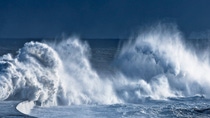
The eco-efficiency analysis says it all.
To demonstrate the environmental impact and ecological benefits of new Elastocoast® technology, an extensive eco-efficiency analysis has been carried out. This involves a life-cycle analysis of various products and processes in terms of their impact on the environment. The ecological assessment is based on DIN EN ISO 14040 and 14044 and has been certified by TÜV (Technical Control Board) Berlin as an overall method. Elastocoast® was compared to traditional coastal protection methods such as concrete and open stone asphalt (OSA) on a surface area of 20,000 m². The most recent study (in 2014) of the Institute of Environmental Hygiene and Toxicology in Gelsenkirchen, Germany, has confirmed the safety of the PU system in coastal protection in terms of toxicology and environ-mental medicine. Long-term monitoring and controls of stability, erosion resistance, recolonization, resistance to weathering and saltwater, and many other parameters have shown that Elastocoast® revetments already achieve top results on the decisive counts.
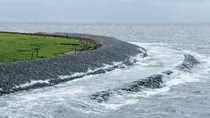
Featured product
Related articles
Consult with an expert
Self-service solutions:
